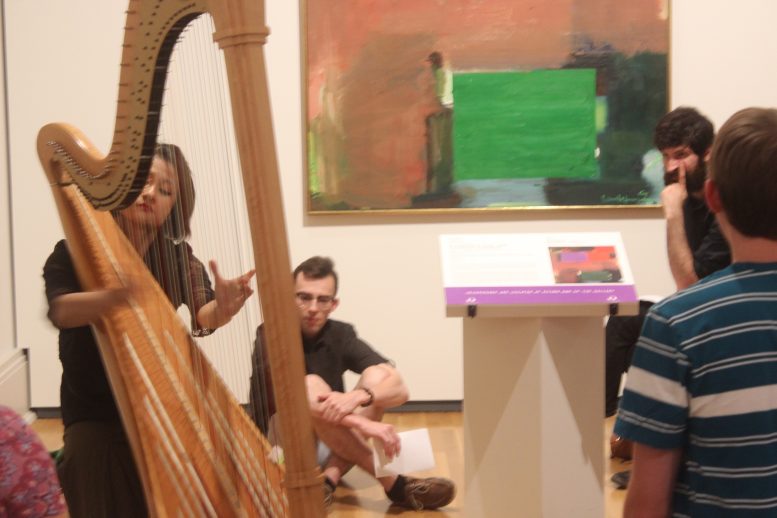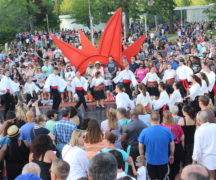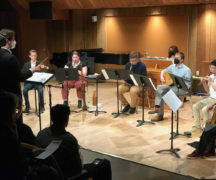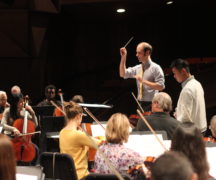By DAVID DUPONT
BG Independent News
EAR / EYE, a joint effort of the university’s College of Musical Arts and the Toledo Museum of Art, marked a milestone Friday evening when the concert series opened its fifth season.
The concerts offer an entertaining and enlightening way to enjoy contemporary music and visual art. Musicians from the Bowling Green State University Doctorate in Contemporary Music program perform in a museum gallery. The individual pieces of music are meant to complement an individual work of art.
Composer Marilyn Shrude from BGSU and Halona Westbrook-Norton, director of curatorial affairs, are on hand to give brief introductions to the music and art, and play up how the sights and sounds interact.
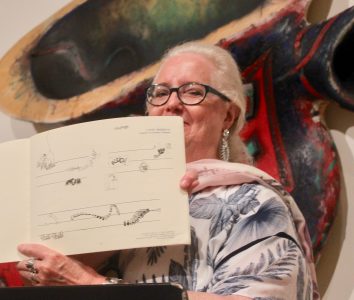
The series, which started in fall, 2015, has been going long enough that students who had just started their doctoral studies at that time graduated this summer. Over those four years, soprano Hillary LaBonte, saxophonist Nick Zoulek, tubist Aaron Hynds, and pianist Zach Nyce all became familiar faces in part because of their EYE / EAR performances.
Friday’s concert featured the four new students in the program, as well as a couple continuing students and two faculty members. Shrude said that this season will feature faculty mentors at times.
Fitting the occasion, Friday’s performance was staged in the New Media Gallery where the show “Everything Is Rhythm” is now on exhibit.
That show was inspired by EAR / EYE, said Scott Boberg, the museum’s manager of programs.
The exhibit is a display of contemporary paintings with recorded music that can be listened to on headphones.
No head phones were needed on Friday.
The proceedings got off to a hilarious start. Standing before Elizabeth Murray’s “Stay Awake,” a 3D painting of coffee cup that explodes from the wall, voice professorJane Schoonmaker Rodgers performed Cathy Berberian’s “Stripsody.”
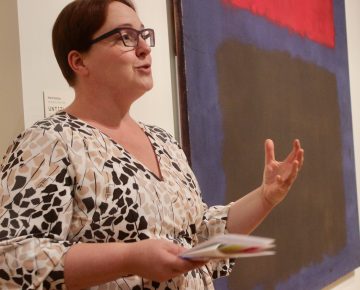
Murray, Westbrook-Norton said, was inspired by popular culture, including cartoons.
The music reflected that. The composer was a singer, and wife of Luciano Berio who pioneered the use of extreme and extremely humorous sounds for voice and other instruments.
Shrude said Berberian’s voice was his muse, and “Stripsody” demonstrated that.
The score itself was a hoot — more cartoon than musical notation. Rodgers did it full justice, eliciting guffaws from the audience as she elicited several Looney Tunes’ worth of sound effects from her voice, punctuating them with facial expressions.
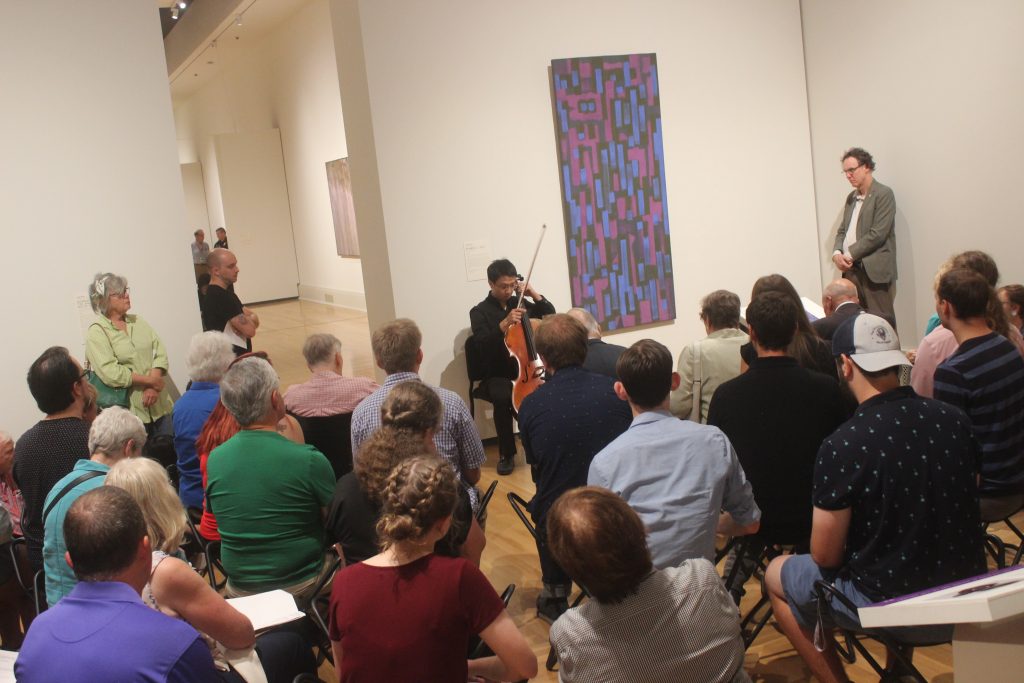
The middle of the program focused on the new students. Hsin Hou Sun, cello, performed George Crumb’s early Sonata for Solo Cello in front of an abstract painting by Ad Reinhardt. The sonata was an early work, written when the composer was the age of the performers. It was redolent of his inspirations Bela Bartok and Paul Hindemith. Sun brought those influences to the fore.
Next the audience, which moves throughout the concert, repositioned themselves in front of Mark Rothko’s “Untitled.” Westbrook-Norton spoke about the painter’s vision of evoking a sense of transcendence in the painting of two large rectangles placed inside a large dark blue rectangles.
Some people, she said, don’t get it.
Rothko himself was known to refuse to sell his work to a buyer if the buyer was just interested in its beautiful color scheme.
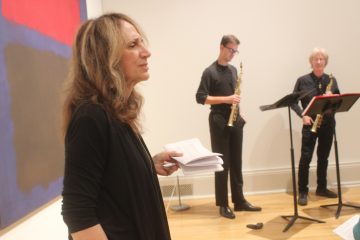
Shrude said the composer Karlheinz Stockhausen was also someone people have strong reactions to. Joshua Heaney with his mentor John Sampen played a duet for soprano saxophone. The piece was originally composed for an opera. The saxophonists represent the Archangel Michael and in the opera they rise out of the floor and then they descend back into the floor, Shrude said. The duo was suitably declarative without such stage business.
Shelly Du, the first harpist in the doctoral program, brought the volume down with two pieces from Caroline Lizotte’s “Suite Galactique.” The first “Hymne au Bon Combat” especially captured in translucent tones the sense of night evoked by the painting “Night Spell” by Hans Hoffman.
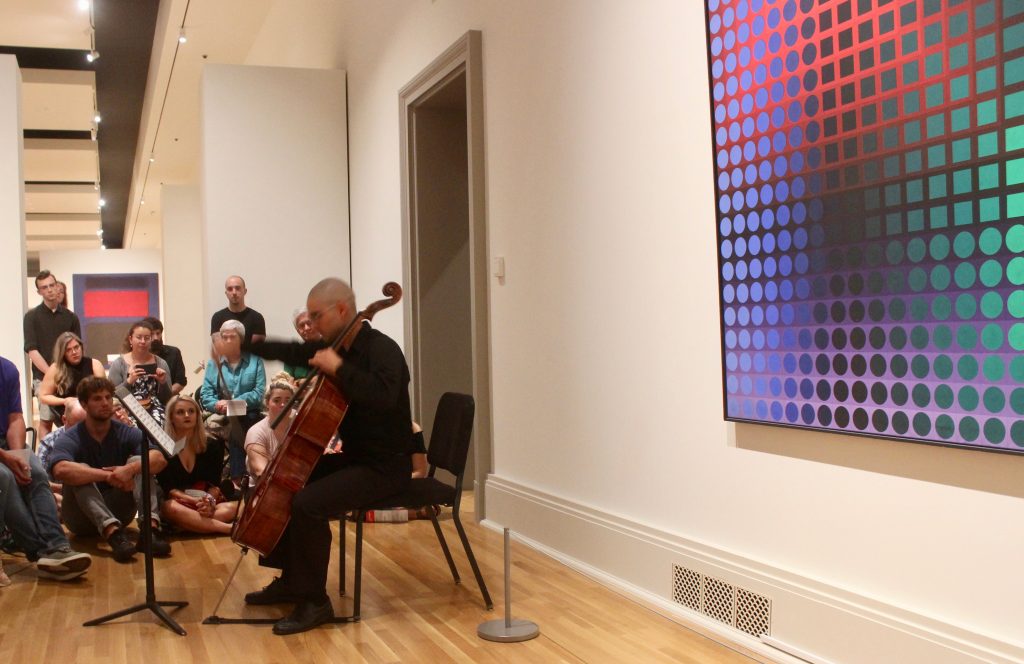
Cellist Otávio Manzano Kavakama performed Witold Lutoslawski’s “Sacher Variations.” Kavakama, from Brazil, also received his master’s degree from BGSU.
Shrude noted that the composer’s use of a musical phrase built from the letters in the last name of conductor Paul Sacher echoes the geometric play with light and shading seen in Victor Vasarely’s “Atom I.” Vasarely, Westbrook-Norton said, is considered the father of Op Art.
Those techniques were apparent as well in the painting on the facing wall of the gallery, Julian Stanczak’s “And Then There Were Three.”
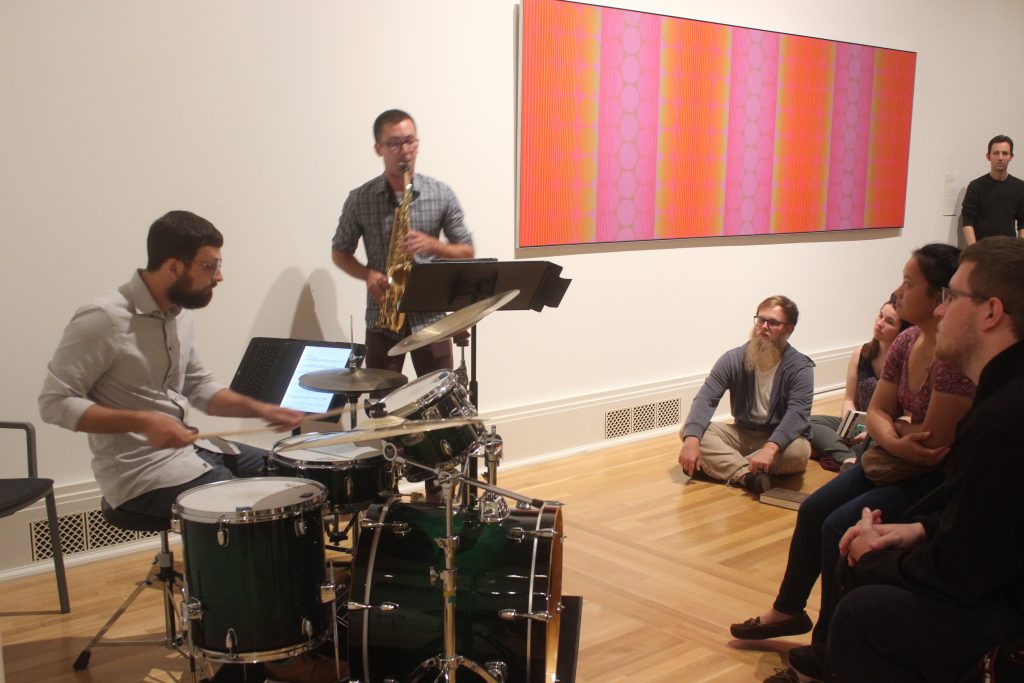
Stanczak was a Pole who was interred in a Siberian labor camp during World War II. He lost the use of his right arm, so he had to retrain himself to paint using his non-dominant left arm. He ended up living in Toledo where he died at age 88 in 2017. The painting, Westbrook-Norton said, has been in storage before being brought out for the “Everything Is Rhythm” exhibit. That’s indicative, she said, of the treasures hidden in the museum’s collection.
The duo Altered Sound — saxophonist Chris Murphy and percussionist Nick Fox— also performed a piece with Ohio connections. Evan Williams, who wrote “Breathe,” received his master’s degree at BGSU. His work was featured during the 4(19) Festival at the museum in August.
The piece had a rock ’n’ roll punch to it, but the melodies could have been lifted from a Baroque sonata, indicative of the composer’s re-imagining classical music traditions. Fox and Murphy ended the concert with a bang, and then a moment of silence.
The next EAR /EYE show will be held Friday, Nov. 8. What gallery it will be staged in has yet to be determined.

